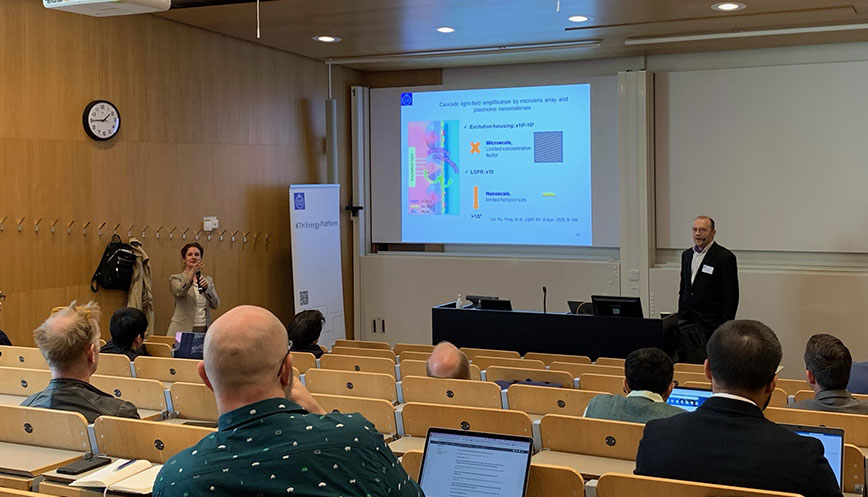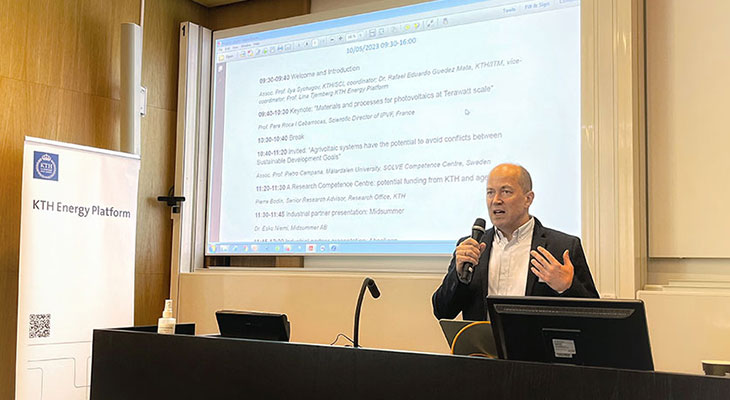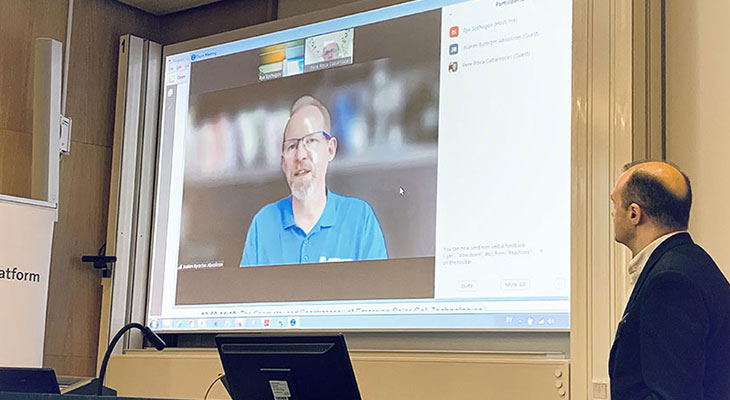Full day on solar energy inspires new research collaborations

In the beginning of May, the Energy Platform arranged a seminar to lay the foundations for greater collaboration in solar energy at KTH.
Participants were welcomed by Ilja Sytjugov, lecturer in Applied Physics, together with KTH Energy Platform Director Lina Bertling Tjernberg.
“The idea to gather all KTH researchers in the solar energy field to share knowledge and experiences with each other came about within the framework of the Energy Platform’s departmental visits last year. The goal is to strengthen research and create more collaborations through new initiatives,” says Bertling Tjernberg.
Sytjugov stressed that much of the knowledge sought internationally in the field actually already exists at KTH. Therefore, a gathering of resources related to solar energy can make a real contribution to strengthening KTH’s research.
“So don’t hesitate to put forward your own ideas for collaborations and projects that could be accommodated within the framework of a new research centre,” says Sytjugov.
The goal to replace fossil fuels
The morning session included presentations of international research and several company presentations. First up was Professor Pere Roca I Cabarrocas, Scientific Director at IPVF in France, who participated via link. He gave an introduction to French research centre IPVF, which develops new materials for tomorrow’s solar cells. He stressed that the goal must be to replace fossil fuels with greater access to renewable energy.
He then gave an overview of currently available technologies and materials for photovoltaics, the technology that converts light energy from the sun into electrical energy.
“In 2022, the world achieved a total solar energy capacity of one terawatt. Most solar cells today are silicon-based due to its robustness, although silicon is not efficient. In recent years, however, a number of new, more effective materials have emerged,” says Roca I Cabarrocas.
Future generations of solar cells may be based on a range of different technologies, such as thin film cells in a variety of materials, perovskite solar cells and tandem solar cells.
“Solar cells based on perovskite are particularly promising as this material is extremely efficient. But we need to find ways to make them more stable to scale up their production and use.”
He stressed that progress must be focused on what gives the best results in addressing the climate challenge. Tomorrow’s solar cells must also be designed to be easy to recycle because they contain scarce materials.
Combining agriculture and solar cells
The next speaker was Pietro Campana, lecturer at Mälardalen University, who presented developments in the field of agrivoltaics, a technology in which agriculture and solar cells coexist on the same land. The combination is already in use in Germany, the Netherlands, Italy, and elsewhere, and is now being tested in Sweden.
“The way these systems are constructed can contribute to better microclimates that produce higher yields, where shade from solar panels results in reduced water use. For farmers, this results in more stable incomes through a combination of solar energy production and agriculture,” says Campana.
An agrivoltaic research project at Kärrbo Prästgård, outside Västerås, has been underway since 2021. The initiative compares different techniques and how they affect harvests. The research has already shown clear production gains with a combination of solar cells and agriculture compared to open fields.
“Now we need a similar regulation on the expansion of these approaches that exist in other countries to build similar solutions in Sweden.”
Campana also gave an introduction to the Solve competence centre, which is funded by the Swedish Energy Agency and brings together six universities and around 50 organisations and businesses. This initiative includes seven areas for the development of everything from solar cell technology to construction technology and large-scale expansion.

Pierre Bodin, Senior Research Advisor for Strategic Initiatives, KTH, then gave an overview of the various forms of research collaboration at KTH.
“Today’s seminar could well be the first step towards a new research centre in solar energy,” says Bodin, who also invited participants to get in touch with their ideas and suggestions for the content of the new initiative.
KTH is currently home to around 50 research centres in various forms, ranging from networks to competence centres and centres of excellence.
Turnkey manufacturing system
Esko Niemi, from the Swedish solar company Midsummer, then gave a presentation about the company’s technology and production. Among other things, he spoke about the company’s proprietary system for the mass production of Duo thin-film solar cells. The system can produce approximately 5 MW per year and is sold as a turnkey solution.
Today, Midsummer has its main production facility in Järfälla, but strong demand for the company’s thin-film solar cells means that they are planning an international expansion, including a large factory in Bari, Italy with the support of the Italian state.
“In Italy, we’re now building a large-scale production facility that will open this year. We’re also expanding in Sweden with an initial goal of reaching a production of approximately 20 MW a year,” says Niemi.
The next company presentation was given by Joakim Byström, CEO of the Härnösand-based company Absolicon. The company manufactures a solar collector that concentrates light to create heat. It works with a recorded efficiency of 70 per cent and 160°C to supply industry and district heating networks with heat.
“We’re now scaling up sales and manufacturing of our entire production line to meet a global need. Our system is very efficient because it is highly robotic and developed according to the needs of our larger customers,” says Byström.

The company has carved out a first niche in the food and beverage industry with companies such as Carlsberg and Peroni on its client list. The company’s solar collectors are installed at several applications around the world, with the most recent orders from Egypt and Canada.
Absolicon also invests in its own R&D, which, among other things, resulted in the self-cleaning and anti-reflective treated glass that covers the solar collectors.
Semi-transparent solar cells
After a networking lunch, there was a series of research presentations. Ilya Sychugov began by speaking about the work of three research groups at the KTH School of Engineering. He touched on the development of semi-transparent solar cells with quantum dots that can cover windows in buildings or vehicles and turn them into electricity producers.
This research can also be applied to functional materials for windows that can change colour or transparency depending on external circumstances or remote control.
Sychugov also gave insights into Professor Anand Srinivasan’s research into nanostructures made of various semiconductor materials, which, among other things, can improve the collection of light for energy conversion. These structures can also be used to give solar cells colours other than black to be more easily placed in more environments than currently is the case.
Lastly, he gave an overview of Haichun Liu’s research, which involves using nanoparticles to make it possible to also capture and use the sun’s ultraviolet and infrared rays. The goal is to increase the efficiency of the solar cells.
James Gardner is a lecturer in photoelectrochemistry and spoke about research being conducted at the Department of Applied Physical Chemistry, where three groups collaborate in the development of new materials for solar cells, mainly on the subject of perovskite. New methods are being developed to deepen the knowledge of the substance’s properties to make it more stable to use for solar cells.
Manufacturing with inkjet technology
Professor Liubov Belova then provided more details about her research into a new manufacturing method for solar cells with perovskite using inkjet technology. Part of the aim is to develop mobile manufacturing systems that print solar cells at a smaller scale where needed. One example could be disaster areas with an urgent need for locally supplied electricity.
Belova also demonstrated how inkjet technology could be used to produce thin oxide-coated films that simultaneously purify water and split it into hydrogen gas.
The next presentation was given by Hatef Madani, a researcher at KTH’s School of Industrial Technology and Management. He showed several research projects from the Division of Applied Thermodynamics and Refrigeration, where broad-based research is conducted on energy use in buildings. Examples include everything from system studies on energy use, and energy flows in city districts to specific components.
Among the examples he cited were models to calculate the profitability of solar cell systems, and the development of geographical solar maps to drive the deployment of solar cells. Madani also spoke about the development of a model to best combine solar cells with geothermal energy, specifically in older geothermal plants.
Multiple EU projects at KTH
Rafael Eduardo Guedez Mata highlighted five ongoing EU projects that are developing large-scale solar cell projects in which KTH researchers are participating in various roles: Solar SCOO2OL, Hybrid plus, Sharp SCO, Susheat, and Powder2Power. These projects include new ways of storing energy from solar cells in the form of heat that are being developed in a range of materials, for example, in metallic by-products and natural materials such as rock, air and liquids.
This was followed by a presentation on the development of new models for combining the use of solar energy with other forms of energy in smart buildings. These solutions use AI technology and sensors, and are able to account for the interaction between buildings and the electricity grid.
One of the last presentations of the day was Makarand Kane, who works on electromagnetic compatibility associated with solar cells. He showed several examples where solar cell installations have given rise to electromagnetic disturbances with greater effect. This is currently an issue that is closely followed by the Swedish Energy Agency and Sweden’s Total Defense Research Institute (TOI).
Sytjugov ended the day together with Bertling Tjernberg with a call to bring forward more ideas and proposals that can be incorporated into efforts to bring together KTH’s research in solar energy.
“The more knowledge we have about each other’s research and projects, the better we will be able to use that knowledge, and the labs and test systems that already exist at KTH. This offers a unique opportunity to make use of knowledge that strengthens KTH’s research,” says Bertling Tjernberg.
Text: Magnus Trogen Pahlén